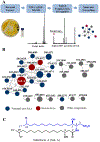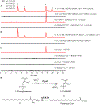Identification and Biosynthesis of Pro-Inflammatory Sulfonolipids from an Opportunistic Pathogen Chryseobacterium gleum
- PMID: 35476918
- PMCID: PMC9275813
- DOI: 10.1021/acschembio.2c00141
Identification and Biosynthesis of Pro-Inflammatory Sulfonolipids from an Opportunistic Pathogen Chryseobacterium gleum
Abstract
Sulfonolipids (SoLs) are a unique class of sphingolipids featuring a sulfonate group compared to other sphingolipids. However, the biological functions and biosynthesis of SoLs in human microbiota have been poorly understood. Here, we report the discovery and isolation of SoLs from a human opportunistic pathogen Chryseobacterium gleum DSM16776. We show for the first time the pro-inflammatory activity of SoLs with mice primary macrophages. Furthermore, we used both in vivo heterologous expression and in vitro biochemical reconstitution to characterize two enzymes, cysteate synthase and cysteate fatty acyltransferase, that are specifically involved in the biosynthesis of SoLs rather than other sphingolipids. Based on these two SoL-specific enzymes, our bioinformatics analysis showed a wider distribution of SoL biosynthetic genes in microbes that had not been reported as SoL producers. We selected four of these strains and verified their cysteate synthase and cysteate fatty acyltransferase activities in SoL biosynthesis. Considering this wider distribution of SoL-specific biosynthetic enzymes in the context of SoLs' activity in mediating inflammation, a common and fundamental biological process, it may suggest a more comprehensive function of SoLs at play.
Conflict of interest statement
The authors declare no competing financial interest.
Figures






Similar articles
-
Identification and Characterization of the Biosynthetic Pathway of the Sulfonolipid Capnine.Biochemistry. 2022 Dec 20;61(24):2861-2869. doi: 10.1021/acs.biochem.2c00102. Epub 2022 Apr 12. Biochemistry. 2022. PMID: 35414181
-
Identification of the Flavobacterium johnsoniae cysteate-fatty acyl transferase required for capnine synthesis and for efficient gliding motility.Environ Microbiol. 2021 May;23(5):2448-2460. doi: 10.1111/1462-2920.15445. Epub 2021 Mar 5. Environ Microbiol. 2021. PMID: 33626217 Free PMC article.
-
Isolation, Structure Elucidation, and Biosynthesis of a Cysteate-Containing Nonribosomal Peptide in Streptomyces lincolnensis.J Org Chem. 2018 Jul 6;83(13):7102-7108. doi: 10.1021/acs.joc.8b00044. Epub 2018 Mar 30. J Org Chem. 2018. PMID: 29557172
-
Chryseobacterium gleum in a man with prostatectomy in Senegal: a case report and review of the literature.J Med Case Rep. 2017 Apr 24;11(1):118. doi: 10.1186/s13256-017-1269-4. J Med Case Rep. 2017. PMID: 28438192 Free PMC article. Review.
-
Drug Targeting of Acyltransferases in the Triacylglyceride and 1-O-AcylCeramide Biosynthetic Pathways.Mol Pharmacol. 2024 Feb 15;105(3):166-178. doi: 10.1124/molpharm.123.000763. Mol Pharmacol. 2024. PMID: 38164582 Review.
Cited by
-
Decreasing of Trimethylamine N-Oxide by Cecal Microbiota and Choline-Trimethylamine Lyase are Associated with Sishen Pill on Diarrhea with Kidney-Yang Deficiency Syndrome.J Inflamm Res. 2024 Oct 13;17:7275-7294. doi: 10.2147/JIR.S470254. eCollection 2024. J Inflamm Res. 2024. PMID: 39429849 Free PMC article.
-
Gut microbiome lipid metabolism and its impact on host physiology.Cell Host Microbe. 2023 Feb 8;31(2):173-186. doi: 10.1016/j.chom.2023.01.009. Cell Host Microbe. 2023. PMID: 36758518 Free PMC article. Review.
-
Human metabolome variation along the upper intestinal tract.Nat Metab. 2023 May;5(5):777-788. doi: 10.1038/s42255-023-00777-z. Epub 2023 May 10. Nat Metab. 2023. PMID: 37165176 Free PMC article.
-
Human gut commensal Alistipes timonensis modulates the host lipidome and delivers anti-inflammatory outer membrane vesicles to suppress colitis in an Il10-deficient mouse model.Gut Microbes. 2025 Dec;17(1):2517380. doi: 10.1080/19490976.2025.2517380. Epub 2025 Jun 11. Gut Microbes. 2025. PMID: 40497338 Free PMC article.
-
Discovery of acylsulfenic acid-featuring natural product sulfenicin and characterization of its biosynthesis.Nat Chem. 2025 Jul;17(7):1011-1019. doi: 10.1038/s41557-025-01833-9. Epub 2025 May 20. Nat Chem. 2025. PMID: 40394187
References
-
- Koppel N; Balskus EP Exploring and understanding the biochemical diversity of the human microbiota. Cell Chem. Biol 2016, 23, 18–30. - PubMed
Publication types
MeSH terms
Substances
Supplementary concepts
Grants and funding
LinkOut - more resources
Full Text Sources
Molecular Biology Databases

